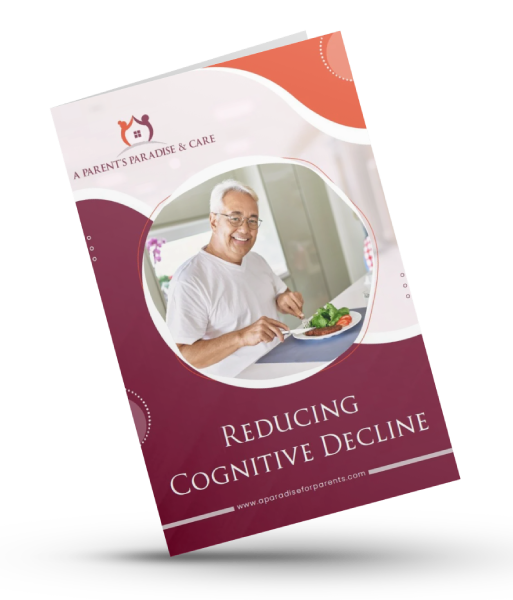We see many residents come into our assisted living homes with chronic health conditions. They have lists of medications prescribed by their doctors that help treat these conditions. Yet many of them have no recommendations for diet. We believe a diet full of the most nutrient dense foods will also help. Many of those chronic conditions are caused by a lack of nutrients. Many nutrient dense foods for elderly people can really improve their health. According to the Kresser Institute, many of the elderly’s problems could be linked to these nutrient deficiencies:
- Vitamin C deficiency can lead to increased waist circumference and blood pressure.
- Vitamin D deficiency hurts your immune system and raises the chances of metabolic syndrome and cardiovascular disease.
- Magnesium deficiency can cause depression, metabolic syndrome, and cardiovascular disease in both younger and older adults.
- Choline deficiency hurts liver function. (8, 9)
- Vitamin B12 deficiency leads to cognitive dysfunction (Alzheimer’s/Dementia) and Parkinson’s-like symptoms. (10)
- Folate deficiency promotes the production of a compound called homocysteine that damages blood vessels when present in large amounts. It can also cause altered gene expression and an increased risk of cancer.
Caloric vs. Most Nutrient Dense Foods for Elderly People
Over time our bodies don’t burn as many calories as it did when we were younger. Nutrient dense foods make it easier to obtain all the vitamins and minerals we need without taking in a lot of calories. Unfortunately, the standard American diet does the exact opposite. Eating fast food and other less nutritious options provide a lot of calories without much in the way of nutrients. A large portion of our American diet is made up of vegetable oils and sugar, which has zero nutritional value.
13 Most Nutrient Dense Foods for Elderly People
According to the Kresser Institute for Functional Medicine’s website, here are the top 9 most nutrient dense foods.
1. Butter from grass-fed cows (preferably raw)
According to Healthline, butter from grass-fed cows are high in Omega-3 fatty acids (26% more than regular butter), 500% more Conjugated Linoleic Acid (strong anti-cancer effects) and much more K2 which helps with bone and hear health. It also contains a lot of Vitamin A, a lot more beta carotene than regular butter. Scientists are also starting to lean more toward the idea that saturated fats are good for you. And butter has a lot of saturated fat.
2. Oysters
Oysters are one of the most nutrient dense foods for elderly people (and everyone else!). They are hard to beat for protein, Omega-3 fatty acids (both DHA and EPA), and Vitamin D (almost two times the daily Recommended Daily Allowance or RDA). They are also a great source for all kinds of minerals. They can provide up to 8x the RDA of Vitamin B12 , which is tough to get through non-animal sources, and up to 15 times the daily need of zinc. And you can receive iron and Selenium too in as little as one serving.
3. Liver from grass-fed animals – A Tasty and Incredibly Nutrient Dense Food
I’m sure everyone groans when I mention Liver. Nobody ever says “I’m really in the mood for liver right now”. They shoud be. Looking back at Healthline again, Liver is incredibly packed with vitamins and minerals. Check these stats out for a 3.5 ounce serving of beef liver:
- Almost 3,500% of the Recommended Daily Intake (RDI) for Vitamin B12
- Over 1,600% of the RDI for Copper (activates enzymes that help with brain function, energy and metabolizing iron)
- As much as 1,100% of the RDI for Vitamin A
- Over 200% of the RDI of Vitamin B2 – also known as Riboflavin
- Up to 80% of the of the RDI of Iron. And most of it is Heme Iron, which is the easiest to absorb by the body
4. Eggs from grass-fed hens
Eggs in general contain a lot of vitamins (all the B vitamins, plus vitamins A, D, E, and K), most of the essential amino acids, and minerals. In particular they contain the minerals Selenium and Iodine which are difficult to obtain from other foods. They also contain Omega 3 fats. Grass-fed or ‘pasture raised’ (what to look for on the label) eggs contain significantly more of some vitamins, such as up to 200% more Vitamin E. You can see why these eggs are one of the most nutrient dense foods for elderly people. The protein helps seniors as well.
5. Cod Liver Oil – One of Mom’s Favorites and Most Nutrient Dense Foods for Elderly People
Back in the old days people would tell stories of mothers making their children take cod liver oil to help prevent rickets due to Vitamin D deficiency. Many seniors are adverse to taking fish oils due to bad memories from when they were a kid.
As usual, mother was right. Cod liver oil contains a lot of Vitamins A and D, plus a healthy amount of Omega 3 fats such as EPA and DHA. Vitamin A is essential for bone growth and night vision, but can also aid in preventing Leukemia.
Vitamin D helps in more ways than just rickets. It can also help prevent hypertension and cancer in people of all ages.
EPA and DHA Omega 3s are great for reducing inflammation – something we see in a lot of elderly people in our assisted living homes. Inflammation can lead to all sorts of problems from gut problems to skin issues.
You can purchase cod liver oil either in soft gels or as a liquid. Many products have been flavored with other natural foods like lemon. The flavors help remove the fishy taste. Be careful that it doesn’t taste to fishy because it may have become rancid.
Cod liver oil is not for everyone, however. Cod liver oil is probably best avoided by pregnant women, asthmatics, and people taking anticoagulants such as warfarin.
6. Fish Eggs
Are you seeing a theme here? Yes – seafood is very healthy. And fish eggs are no exception. Although caviar is the most well-known form of fish eggs (eggs from Sturgeon), there is another style of fish eggs known a Roe. Roe are eggs from a whole host of different fish – trout, whitefish, salmon, carp or even shellfish. Some of the fish eggs can be poisonous, so be careful with these.
A single serving of fish eggs contain 133 percent of your daily dose of vitamin B12, 18 percent of choline, 15% of magnesium and 19% of selenium. Many of these minerals are difficult to obtain from other foods. Many seniors lack these minerals in their diets.
https://www.youtube.com/watch?v=uq7iLK_T6kc
Everyone thinks of caviar as food for only the rich and famous. However, you can find many other varieties of fish eggs in grocery stores for as little as $10. The best way to find fish eggs is from a local fish market. They will be most available in spring when the fish are spawning.
You can also buy them online. Just don’t confuse them with the fish eggs given to fish in an aquarium. Seafood in general is one of the most nutrient dense foods for elderly people and should be part of anyone’s diet.
7. Whole Raw Milk from Grass-Fed Cows
There are lots of beneficial reasons to drink raw milk, and maybe some drawbacks. The benefits include:
- Lots of nutrients – Vitamin A, magnesium, zinc, thiamine, iron and calcium. Grass fed cows also contain higher amounts of omega-3 fatty acids
- A great source of quality raw protein. Considered a complete protein, raw milk contains all nine of the essential amino acids that your body needs
- Bone health. That’s because raw milk contains calcium, phosphorous, potassium and (for grass fed raw milk) Vitamin K2 which has lots of additional benefits
- Prevents weight gain – A study of 18,000 elderly women showed that eating more dairy with high fat content helped them lower their chances of becoming obese
- It is a great addition to other healthy recipes such as smoothies, coffee, tea, soups and oatmeal
Be careful when buying raw milk. Although raw milk is one of the most nutrient dense foods for elderly people, many states have made it illegal because people believe it increases the chances of food poisoning. Here is a map from the CDC showing the legal status and number of recent outbreaks by state:
8. Bone Broth
Very beneficial in protecting bones and teeth. Specifically the benefits include:
- Lots of vitamins and nutrients that are very beneficial for bones and teeth. These nutrients include calcium, magnesium and phosporous
- Tissues and bones that make up the broth also contain collagen. When you heat collagen, it turns into gelatin. Gelatin makes amino acids. The amino acids then combine into protein
- Collagen also protects the joints. By consuming gelatin, the joints can help repair the collagen that has been worn down over the years for eldlerly people
- Repairing joints with collagen means elderly people can lessen their symptoms of joint pain such as osteoarthritis
- An anti-inflammatory amino acid called Glutamine in bone broth helps to promote gut health
- Glycine, an amino acid in bone broth, can help promote more restful sleep
9. Wild Salmon
Back to the fish. Salmon is a great fish to consume. It eats mostly algae so has much less mercury buildup. Wild salmon is better than factory-farmed salmon because there may be build-up of PCBs and dioxins in the factory farmed salmon.
Factory farmed salmon is illegal in Alaska. So any Salmon you buy from Alaska is wild-caught.
The benefits of salmon are numerous:
- Healthy Hearts – Omega 3 fats help reduce blood clots and lower blood pressure. Blood pressure problems are very prevalent in seniors
- Brain booster – DHA fats in Salmon may be the most important fat for reducing cognitive decline in our elderly population
- Anti-cancer – Once a week consumption of salmon can reduce cancer risk significantly. Specifically, it reduces the risk of breast, colon, prostate cancers. It also help with Leukemia, myeloma and Non-Hodgkins Lymphoma.
- Macular Degeneration is a horrible eye disease that hits seniors hard. It robs them of their site gradually. The omega-3 fats in salmon help combat this condition
Although these foods are quite unusual, they can really make a difference in the health of the elderly. We’re finding some great results by serving nutrient dense foods in our assisted living homes. The idea that senior nutrition can really make a difference in their health is growing more and more. Why not try some of these foods to see if they can make a difference? Or if you have some other suggestions, please leave them in the comments below.





